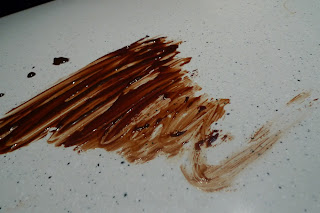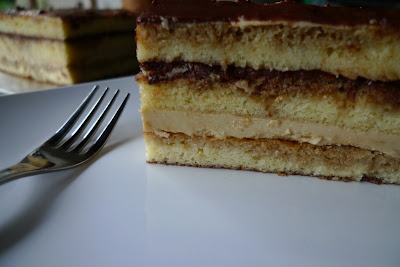It all started with this cake. This was way back in december 2009. My first foray into food photography. I can't recall why I chose to make this cake. But damn. It was delicious. The Opera cake or L'Opera was created in Paris in 1900s at a pastisserie called Dalloyau. It is a multi layered cake composed of 6 layers: 3 layers of Joconde (soaked in coffee syrup) ,a layer of coffee buttercream and bittersweet chocolate ganache and finally topped with chocolate glaze. A joconde is a french almond cake, pretty much a sponge cake with an almond-ny flavour. Surprisingly, the cake was not as rich I expected it to be with all those layers.
It took me about 5 hours to assemble the cake having to make each component separately but the results were worth it. Not too bad for my first attempt at a layered cake. If I had to make this cake again, I would make the joconde thinner and ensure that the cake is really cold before pouring over the glaze. If you are short on time, you can make each element on different days and assemble them whenever you're ready.
 |
| The layering process minus the last 2 steps. |
Opera Cake
Adapted from Dalloyau from Paris Sweets: Great Desserts from the City's Best Pastry Shopsby Dorie Greenspan (Broadway Books, 2002)
Ingredients
Makes about 20 servings
The cake:
Makes about 20 servings
The cake:
- 6 large egg whites, at room temperature
- 2 tablespoons (30 grams) granulated sugar
- 2 cups (225 grams) ground blanched almonds
- 2 1/4 cups (225 grams) confectioners sugar, sifted
- 6 large eggs
- 1/2 cup (70 grams) all-purpose flour
- 3 tablespoons (45 grams) unsalted butter, melted and cooled briefly
The coffee syrup:
- 1/2 cup water
- 1/3 cup sugar
- 1 1/2 tablespoons (7 grams) instant espresso or coffee
The coffee buttercream:
- 2 tablespoons (10 grams) instant espresso or coffee
- 2 tablespoons (15 grams) boiling water
- 1 cup (100 grams) sugar
- 1/4 cup (30 grams) water
- Pulp of 1/4 vanilla bean
- 1 large whole egg
- 1 large egg yolk
- 1 3/4 sticks ( 200 grams) unsalted butter, at room temperature
The chocolate ganache:
- 8 ounces (240 grams) bittersweet chocolate, finely chopped
- 1/2 cup (125 grams) whole milk
- 1/4 cup (30 grams) heavy cream
- 4 tablespoons ( 60 grams) unsalted butter, at room temperature
The chocolate glaze:
- 5 ounces (150 grams) bittersweet chocolate, finely chopped
- 1 stick (115 grams) unsalted butter
Instructions
1. To make the cake: Position the racks to divide the oven into thirds and preheat the oven to 220 degrees C. Line two 12 1/2-x15 1/2-inch (31-x-39-cm) jelly-roll pans with parchment paper and brush with melted butter. (This is in addition to the quantity in the ingredient list.)
2. Working in a clean dry mixer bowl fitted with the whisk attachment, beat the egg whites until they form soft peaks. Add the granulated sugar and beat until the peaks are stiff and glossy. If you do not have another mixer bowl, gently scrape the whites into another bowl.
3. In a mixer fitted with the paddle attachment, beat the almonds, confectioners sugar and whole eggs on medium speed until light and voluminous, about 3 minutes. Add the flour and beat on low speed only until it disappears. Using a rubber spatula, gently fold the meringue into the almond mixture, then fold in the melted butter. Divide the batter between the pans and spread it evenly to cover the entire surface of each pan.
4. Bake the cakes for 5 to 7 minutes, or until they are lightly browned and just springy to the touch. Put the pans on a heatproof counter, cover each with a sheet of parchment or wax paper, turn the cakes over and unmold. Carefully peel away the parchment, turn the parchment over and use it to cover the exposed sides of the cakes. Let the cakes come to room temperature between the parchment or wax paper sheets. (The cakes can be made up to 1 day ahead, wrapped and kept at room temperature.)
5. To make the syrup: Stir everything together in a small saucepan and bring to the boil. Cool. (The syrup can be covered and refrigerated for up to 1 week.)
6. To make the buttercream: Make a coffee extract by dissolving the instant espresso in the boiling water; set aside.
7. Bring the sugar, water and vanilla bean pulp to a boil in a small saucepan; stir just until the sugar dissolves. Continue to cook without stirring until the syrup reaches 124 degrees C, as measured on a candy or instant-read thermometer. Pull the pan from the heat.
8. While the sugar is heating, put the egg and the yolk in the bowl of a mixer fitted with the whisk attachment and beat until the eggs are pale and foamy. When the sugar is at temperature, reduce the mixer speed to low and slowly pour in the syrup. Inevitably, some syrup will spin onto the sides of the bowl - don't try to stir the spatters into the eggs. Raise the speed to medium-high and continue to beat until the eggs are thick, satiny and room temperature, about 5 minutes.
9. Working with a rubber spatula, beat the butter until it is soft and creamy but not oily. With the mixer on medium speed, steadily add the butter in 2-tablespoon (30-gram) chunks. When all the butter has been added, raise the speed to high and beat until the buttercream is thickened and satiny. Beat in the coffee extract. Chill the buttercream, stirring frequently, until it is firm enough to be spread and stay where it is spread when topped with a layer of cake, about 20 minutes. (The buttercream can be packed airtight and refrigerated for 4 days or frozen for 1 month; before using, bring it to room temperature, then beat to smooth it.)
10. To make the ganache: Put the chocolate in a medium bowl and keep it close at hand. Bring the milk and cream to a full boil, pour it over the chocolate, wait 1 minute, then stir gently until the ganache is smooth and glossy.
11. Beat the butter until it is smooth and creamy, then stir it into the ganache in 2 to 3 additions. Refrigerate the ganache, stirring every 5 minutes, until it thickens and is spreadable, about 20 minutes. (The ganache can be packed airtight and refrigerated for up to 3 days or frozen for 1 month; bring to room temperature before using.)
12. To assemble the cake: Line a baking sheet with parchment or wax paper. Working with one sheet of cake at a time, trim the cake so that you have two pieces: one 10-x-10-inches (25-x-25-cm) square and one 10-x-5-inches (25-x-12.5-cm) rectangle. Place one square of cake on the parchment and moisten the layer with coffee syrup. Spread about three-quarters of the coffee buttercream evenly over the cake. (If the buttercream is soft, put the cake in the freezer for about 10 minutes before proceeding.) Top with the two rectangular pieces of cake, placing them side by side to form a square; moisten with syrup. Spread the ganache over the surface, top with the last cake layer, moisten, then chill the cake in the freezer for about 10 minutes. Cover the top of the cake with a thin layer of coffee buttercream. (This is to smooth the top and ready it for the glaze - so go easy.) Refrigerate the cake for at least 1 hour or for up to 6 hours; it should be cold when you pour over the glaze. If you're in a hurry, pop the cake into the freezer for about 20 minutes, then continue.
13. To glaze the cake: Bring the butter to a boil in a small saucepan. Remove the pan from the heat and clarify the butter by spooning off the top foam and pouring the clear yellow butter into a small bowl; discard the milky residue. Melt the chocolate in a bowl over—not touching—simmering water, then stir in the clarified butter. Lift the chilled cake off the parchment-lined pan and place it on a rack. Put the rack over the parchment-lined pan and pour over the glaze, using a long offset spatula to help smooth it evenly across the top. Slide the cake into the refrigerator to set the glaze and chill the cake, which should be served slightly chilled. At serving time, use a long thin knife, dipped in hot water and wiped dry, to carefully trim the sides of the cake so that the drips of glaze are removed and the layers revealed.
Storing: Each element of the cake can be made ahead, as can the assembled cake. The cake can be kept in the refrigerator, away from foods with strong odors, for 1 day, or you can freeze the cake, wrap it airtight once it is frozen, and keep it frozen for 1 month; defrost, still wrapped, overnight in the refrigerator.
If you do not have the exact baking pan dimension, roughly pour in about 1-2cm worth of batter into whatever pan you have in your kitchen. You might have to do this 3-4 times depending on how small/big your pan is. Adjust the baking time as necessary. The raw batter cannot be kept thus I suggest that you bake everything and freeze the leftovers. Do note that this is traditionally a square cake and individual servings are sliced into rectangles.
Ensure that the topmost layer of buttercream is smooth and cold to the touch before pouring the glaze over. This will ensure a nice unblemished top.
The cake should be taken out of the fridge and left at room temperature before serving as the buttercream will tend to solidify when it's cold.
 |
| What do you do you've got leftover glaze? Make a mess! |



No comments:
Post a Comment